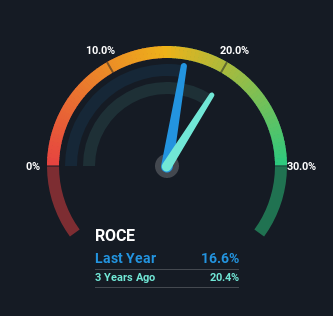Here's What's Concerning About Purcari Wineries' (BVB:WINE) Returns On Capital
If you're looking for a multi-bagger, there's a few things to keep an eye out for. Ideally, a business will show two trends; firstly a growing return on capital employed (ROCE) and secondly, an increasing amount of capital employed. If you see this, it typically means it's a company with a great business model and plenty of profitable reinvestment opportunities. Having said that, from a first glance at Purcari Wineries (BVB:WINE) we aren't jumping out of our chairs at how returns are trending, but let's have a deeper look.
Return On Capital Employed (ROCE): What is it?
Just to clarify if you're unsure, ROCE is a metric for evaluating how much pre-tax income (in percentage terms) a company earns on the capital invested in its business. The formula for this calculation on Purcari Wineries is:
Return on Capital Employed = Earnings Before Interest and Tax (EBIT) ÷ (Total Assets - Current Liabilities)
0.17 = RON54m ÷ (RON454m - RON130m) (Based on the trailing twelve months to December 2021).
Therefore, Purcari Wineries has an ROCE of 17%. On its own, that's a standard return, however it's much better than the 9.9% generated by the Beverage industry.
View our latest analysis for Purcari Wineries

In the above chart we have measured Purcari Wineries' prior ROCE against its prior performance, but the future is arguably more important. If you'd like to see what analysts are forecasting going forward, you should check out our free report for Purcari Wineries.
The Trend Of ROCE
When we looked at the ROCE trend at Purcari Wineries, we didn't gain much confidence. Over the last five years, returns on capital have decreased to 17% from 33% five years ago. However, given capital employed and revenue have both increased it appears that the business is currently pursuing growth, at the consequence of short term returns. And if the increased capital generates additional returns, the business, and thus shareholders, will benefit in the long run.
On a side note, Purcari Wineries has done well to pay down its current liabilities to 29% of total assets. So we could link some of this to the decrease in ROCE. Effectively this means their suppliers or short-term creditors are funding less of the business, which reduces some elements of risk. Since the business is basically funding more of its operations with it's own money, you could argue this has made the business less efficient at generating ROCE.
In Conclusion...
While returns have fallen for Purcari Wineries in recent times, we're encouraged to see that sales are growing and that the business is reinvesting in its operations. And the stock has followed suit returning a meaningful 32% to shareholders over the last three years. So should these growth trends continue, we'd be optimistic on the stock going forward.
Purcari Wineries does have some risks though, and we've spotted 3 warning signs for Purcari Wineries that you might be interested in.
While Purcari Wineries may not currently earn the highest returns, we've compiled a list of companies that currently earn more than 25% return on equity. Check out this free list here.
New: Manage All Your Stock Portfolios in One Place
We've created the ultimate portfolio companion for stock investors, and it's free.
• Connect an unlimited number of Portfolios and see your total in one currency
• Be alerted to new Warning Signs or Risks via email or mobile
• Track the Fair Value of your stocks
Have feedback on this article? Concerned about the content? Get in touch with us directly. Alternatively, email editorial-team (at) simplywallst.com.
This article by Simply Wall St is general in nature. We provide commentary based on historical data and analyst forecasts only using an unbiased methodology and our articles are not intended to be financial advice. It does not constitute a recommendation to buy or sell any stock, and does not take account of your objectives, or your financial situation. We aim to bring you long-term focused analysis driven by fundamental data. Note that our analysis may not factor in the latest price-sensitive company announcements or qualitative material. Simply Wall St has no position in any stocks mentioned.
About BVB:WINE
Purcari Wineries
Through its subsidiaries, engages in the production, bottling, and sale of wines in Central and Eastern Europe.
High growth potential and fair value.
Similar Companies
Market Insights
Community Narratives



